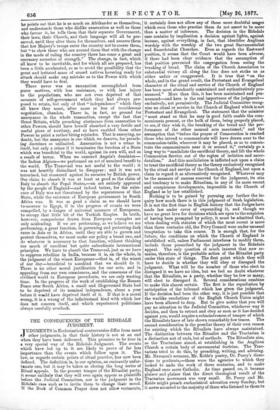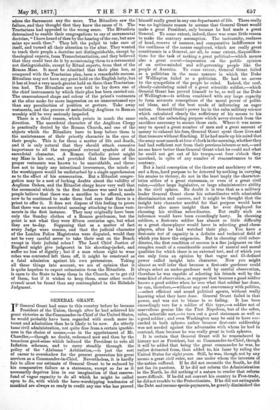THE CONSEQUENCES OF THE RIDSDAL11 JUDGMENT.
TUDGMENTS in Ecclesiastical controversies differ from most other judgments, in that their history is not at an end when they have been delivered. This promises to be true in a very special way of the Ridsdale Judgment. The events which have led up to it are likely to prove of far less importance than the events which follow upon it. The law, as regards certain points of ritual practice, has now been defined. The definition is, in our opinion, an eminently unfor- tunate one, but it may be taken as closing the long series of Ritual appeals. In the present temper of the Ritualist party, it seems unlikely that they will ever again appear as plaintiffs before the Judicial Committee, nor is the judgment in the Ridsdale case such as to invite them to change their mood. If the Book of Common Prayer does not allow vestments, it certainly does not allow any of those more doubtful usages which even those who practise them do not assert to be more than a matter of inference. The decision in the Ridsdale case contains by implication a decision against lights, against incense, against everything, in fact, that identifies Anglican worship with the worship of the two great Sacramentalist and Sacerdotalist Churches. Even as regards the Eastward position, it seems that the Court would have been adverse, if there had been clear evidence that the assumption of that position prevented the congregation from seeing the breaking of bread. The claim of the Church Association to substantial victory all along the line does not strike us as either unfair or exaggerated. It is true that "on the whole, and in the grand result, the Protestant and Evangelical character of the ritual and service of the Church of England has been most abundantly maintained and authoritatively pro- nounced." More than this, it has been maintained and pro- nounced—and here is the real importance of the judgment— exclusively, not permissively. The Judicial Committee recog- nise no ritual or service in the Church of England which is not Protestant and Evangelical. The statement that the minister "must stand so that he may in good faith enable the com- municants present, or the bulk of them, being properly placed, to see, if they wish it, the breaking of the bread and the per- formance of the other manual acts mentioned," and the assumption that "before the prayer of Consecration is reached those who intend to communicate will have drawn near to the communion-table, wherever it may be placed, so as to concen- trate the communicants near it or around it," certainly go a long way to "annihilate the sacrificial theory, and lift the whole Communion Service out of the region of isolation and sacer- dotalism." And this annihilation is inflicted not upon a claim to treat the sacrificial theory as the theory exclusively recognised by the ritual and service of the Church of England, but upon a claim to regard it as alternatively recognised. Whatever may be the measure of success reserved for the judgment, its aim and tendency is to make Ritualism, in any of its more recent and conspicuous developments, impossible in the Church of England as by law established.
Nothing is to be gained by pursuing any further the in- quiry how much there is in this judgment of fresh legislation.
It is not the first time in English history that the Judges have made law under cover of expounding it, and though we have no great love for decisions which are open to the suspicion of having been prompted by policy, it must be admitted that, when dealing with statutes of which the most recent is more than three centuries old, the Privy Council were under unusual temptation to take this course. It is enough that, for the future the conditions on which the Church of England is established will, unless Parliament interferes to modify them, include those prescribed by the judgment in the Ridsdale appeal. The only question of much interest that now re- mains, therefore, is the probable action of the Ritualist party under this state of things. The first point which they will have to decide is whether they will obey or disregard the judgment. What will be the number of those who elect to disregard it we have no idea, but we feel no doubt whatever that the Ritualists, as a party, whether they be few or many, will elect to disregard it. Several considerations combine to make this almost certain. The first is the repudiation by anticipation of the tribunal which has given the judgment. If the decision had been the other way, it is just possible that the warlike resolutions of the English Church Union might have been allowed to drop. But to give notice that you will pay no attention to the Judicial Committee, whichever way it decides, and then to retract and obey as soon as it has decided against you, would require a submissiveness of temper of which the Ritualists have of late shown remarkably few traces. The second consideration is the peculiar theory of their own reason for existing which the Ritualists have always maintained. The distinction between the Ritualist and the Tractarian is a distinction not of ends, but of methods. The Ritualists aim, as the Tractarians aimed, at establishing in the Anglican Church a certain body of sacramental doctrine. The Trac- tarians tried to do this' by preaching, writing, and advising. Mr. Newman's sermons, Mr. Keble's poetry, Dr. Pusey's direc- tions to penitents,—these were the agencies to which they looked to undo the work of three centuries, and to make England once more Catholic. As time passed on, it became plainer and plainer that the direct theological result of the Tractarian movement was very small. Dr. Pusey and Mr. Keble might preach eucharistical adoration every Sunday, but it never occurred to the majority of those who listened to them to
adore the Sacrament any the more. The Ritualists saw the failure, and they thought that they knew the cause of it. The Tractarians had appealed to the wrong sense. The Ritualists determined to enable their congregations to say of sacramental doctrine, " I have heard of thee by the hearing of the ear, but now mine eye seeth thee." They left the pulpit to take care of itself, and turned all their attention to the altar. They wanted to teach their people a doctrine not distinguishable, except by theological experts, from Transubstantiation, and they believed that they could best do it by accustoming them to a ceremonial not distinguishable, except by Ritual experts, from that of the Roman Mass. It must be admitted that their plan has, as compared with the Tractarian plan, been a remarkable success. Ritualism may not have any great hold on the English laity, but it has at least a very much greater hold on them than Tractarian- ism had. The Ritualists are now told to lay down one of the chief instruments by which their plan has been carried out. The unaccustomed shape and colour of the priest's vestments at the altar make far more impression on an unaccustomed eye than any peculiarities of position or gesture. Take away vestments, and the process of assimilating Anglican to Roman worship will be very seriously impeded.
There is a third reason, which points in much the same direction. The sacerdotal character of the Anglican Clergy is practically denied by the Roman Church, and one of the objects which the Ritualists have to keep before them is the maintenance of their priestly character in the eyes of their people. This is for them a matter of life and death, and it is only natural that they should attach excessive importance to all the recognised external symbols of the sacerdotal character. A Roman Catholic priest might say Mass in his coat, and provided that the disuse of the proper vestments was known to be unavoidable, and there- fore not to imply any intentional irreverence, the minds of the worshippers would be undisturbed by a single apprehension as to the effect of his consecration. But a Ritualist congre- gation may be a nest of lurking doubts about the validity of Anglican Orders, and the Ritualist clergy know very well that the ceremonial which in the first instance was used to make people believe that there was a sacrifice to be offered, needs now to be continued to make them feel sure that there is a priest to offer it. It does not dispose of this feeling to prove that there was no sacerdotal meaning attaching to these vest- ments in the first instance. They may originally have been only the Sunday clothes of a Roman gentleman, but the point is not what they were fifteen centuries ago, but what they are to-day. Supposing that as a matter of fact every Judge wore ermine, and that the judicial character of the London Police Magistrates were disputed, would they not be very careful never to take their seat on the Bench except in their judicial robes ? The Lord Chief Justice of England might give judgment in his shooting-jacket, and suffer no loss of dignity • but if a man whose right to wear robes was contested left them off, it might be construed as a fatal admission against his own pretensions. Taking all these things into account, we are of opinion that it is quite hopeless to expect submission from the Ritualists. It is open to the State to keep them in the Church, or to get rid of them, but if it wishes to keep them, some other modus vivendi must be found than any contemplated in the Ridsdale Judgment.



































 Previous page
Previous page